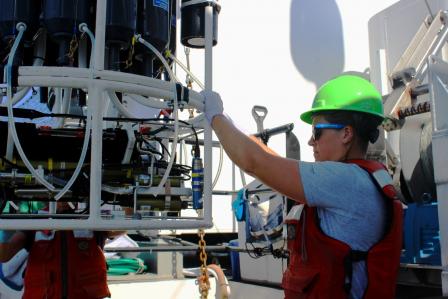Great Lakes Water Quality Monitoring Program Physical Parameters
Physical parameters, including water temperature, air temperature, incident light, Secchi depth, wind speed, wave height, dissolved oxygen and baromentric pressure are measured at each GLNPO sampling station on the Great Lakes. The Rosette water sampler is outfitted with a Sea-Bird multi-parameter profiler (conductivity, temperature and depth) and other probes which can measure the listed parameters.
Water temperature is important for chemical, physical and biological processes in the lakes. Monitoring water temperature is critical for understanding any shifts in lake productivity.
Wind speed and Wave height both influence the water column in the lakes. By influencing how the water is mixed, wind speed and wave action can alter the temperature and turbidity at different depths in the water column and therefore affect both water quality and aquatic life.
Incident light and Secchi depth are both related to primary productivity in the lakes. When sunlight reaches deeper depths in the water column, photosynthesis (primary production) can occur deeper in the water column. Incident light is the sunlight that strikes the water surface. A Secchi disk![]() Secchi diskA black and white patterned disk used to measure the clarity of water in visibility distance., which has alternating black and white quadrants, is used to measure Secchi depth. The Secchi disk is lowered into the water until it is no longer visible by the observer, with this depth of disappearance called the Secchi depth. Secchi depth is a measure of transparency, or general clarity, of the water.
Secchi diskA black and white patterned disk used to measure the clarity of water in visibility distance., which has alternating black and white quadrants, is used to measure Secchi depth. The Secchi disk is lowered into the water until it is no longer visible by the observer, with this depth of disappearance called the Secchi depth. Secchi depth is a measure of transparency, or general clarity, of the water.
Dissolved oxygen (DO) is important for chemical and biological processes in the lakes. Fish and other aerobic![]() aerobicLife or processes that can occur only in the presence of oxygen. aquatic organisms need oxygen to survive, so monitoring DO is key to understanding the health of the lake ecosystems. High abundance of algae and other phytoplankton can deplete oxygen in an area of the lake, leading to anoxic
aerobicLife or processes that can occur only in the presence of oxygen. aquatic organisms need oxygen to survive, so monitoring DO is key to understanding the health of the lake ecosystems. High abundance of algae and other phytoplankton can deplete oxygen in an area of the lake, leading to anoxic![]() anoxicAquatic environmental conditions containing zero or little dissolved oxygen. or hypoxic
anoxicAquatic environmental conditions containing zero or little dissolved oxygen. or hypoxic![]() hypoxicA condition of low oxygen concentration, below that considered aerobic. conditions, which threaten aquatic life. DO monitoring is a particular focus in Lake Erie. Lake Erie is the shallowest, warmest and most productive Great Lake, which make it more susceptible to anoxic and hypoxic conditions.
hypoxicA condition of low oxygen concentration, below that considered aerobic. conditions, which threaten aquatic life. DO monitoring is a particular focus in Lake Erie. Lake Erie is the shallowest, warmest and most productive Great Lake, which make it more susceptible to anoxic and hypoxic conditions.
 The Sea-Bird multi-parameter profiler and other probes are attached to the R/V Lake Guardian's Rosette water sampler and deployed at each sampling station on the Great Lakes.
The Sea-Bird multi-parameter profiler and other probes are attached to the R/V Lake Guardian's Rosette water sampler and deployed at each sampling station on the Great Lakes.
